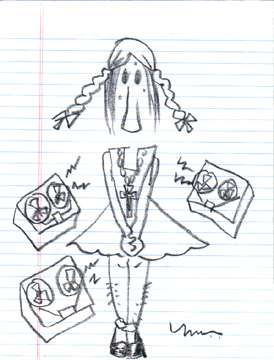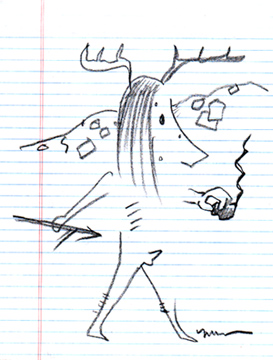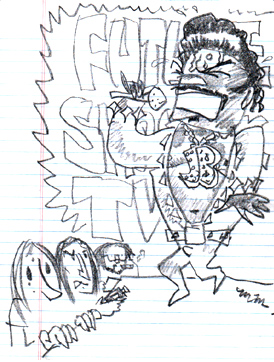Mike Kelley and Meme
12 Sep 2012
Note: Gerry Fialka presents PXL THIS 21 at OTHER CINEMA on Saturday, October 13, 2012!
Artist Mike Kelley continues to inspire and perplex me. His Menippean meme of archeology and anthropology as art nurtures and empowers us. His acclaimed influence will flourish, and the shock of his suicide will not let up. Sanctifying stoic simultaneity?
We had similar backgrounds, raised Catholic in the early ‘50s in southeast Michigan. We were both pictured in hometown newspapers for winning high school poster design contests. We studied art and psychology at the University of Michigan in the ‘70s, and spent the last three decades in Los Angeles. We both got into sewing. We ventured into dumpster diving—one man’s trash is another man’s art medium. We both mined the relationships of ‘60s subcultures to social-political concerns. We got our jobs and lives as mixed up as possible. We were both scraggly ass white dudes, knee deep in reverently satirizing what we dearly love.
We non-conformists are all alike, digging Captain Beefheart, Art Ensemble of Chicago, Iggy & The Stooges, Sun Ra, John Cage, John Lee Hooker, MC5, and Funkadelic. Our art consumption crossed into Dada, Fluxus, Jack Smith, Robert Crumb, and Joseph Beuys who wrote his own new chapter to James Joyce ’s Finnegans Wake (“where the hand of man never set foot”). Beuys said “Make the secrets productive.” In his 1981 artwork Meditation on a Can of Vernors, Mike asked about the gnome mascot of this product—Vernor’s ginger ale pop can: “does he have a secret?” He added, “I’m attracted to these overtones of secrecy.”

I was duly astonished in Diane Kirkpatrick’s History of Art class at U of M in Ann Arbor when Mike, dressed in a Catholic girl’s Holy Communion dress yelped psycho-babble poetry through three reel-to-reel tape players presaging digital delay soundscapes. We shared an appreciation for Frank Zappa, who pioneered this idea of studio as instrument. Mike said: “Performances were about belief systems. I thought of them as propaganda-gone-wrong.” Frank asked the question: “Who are the brain police?”
Unlike many, Mike achieved renown but did not desert his street roots. I was truly grateful for his not only responding to my interview requests, but actually following through. His generous contributions to LA’s literary art center, Beyond Baroque, have been befittingly appreciated. The upstairs gallery is now dedicated to Mike. He did not require any rental fee when we screened his feature film DAY IS DONE at our 7 Dudley Cinema series, knowing that we are all-volunteer, always-free-admission and welcome the homeless.
As Ken Johnson wrote in the New York Times, August 17, 2012: “Mike Kelley, the celebrated Los Angeles artist who took his own life at 57 this year, was a hero to many. But partly because he so determinedly defied traditional laws of stylistic consistency and coherence, the number of people who fully grasped what he was about is probably small.” Small? Hell, I’d put that closer to zero. And that’s probably what Mike wanted. I feel Mike’s art was constantly mocking his own existential despair. Could anyone really ever get Mike? And more important, were we supposed to?
McLuhan nailed it—“Understanding is NOT having a point of view”—even as he teased folks to believe his percepts were theories. Similarly, Mike said: “I tend to use writers and theories for my own ends.” Kelley merged language and image to transform art and noise into a transcenDANCE.
...Mike’s art was constantly mocking his own existential despair. Could anyone really ever get Mike? And more important, were we supposed to?
Robert Pincus, reviewing Kelley’s Monkey Island show at Beyond Baroque in Art In America, September 1983, noted, “He attempts to understand rather than judge, to analyze human drives and desires, to dissect our foibles.”
In Artforum, May 2012, Ann Goldstein reinforces that duality: “Mike used binary structures as a means to communicate as an artist, setting up correspondence between order and chaos, the analytical and the associative, the practical and the speculative, belief systems and propaganda, the every day and the uncanny.”
In that same issue, Tony Oursler explained “...signature Mike: First, we are struck by an anarchic and often biting humor, which unfolds to reveal a deeply mysterious yet considered logic, which then evaporates back into our world, leaving us to ponder our predicament.” Percept pondering as plunder?
The exuberant embrace of contradiction is key to experiencing Mike Kelley. As Duchamp said “The artist in the future would be a person who points his finger” and, “I want to contradict myself in order to avoid conforming to my own taste.” Pointing at that meme, are you looking at the finger or the meme?
The word “meme” (the double me) relates to cultural transmission and memory. It was at the center of my two Kelley interviews. The Pacifica Radio one was 18 years ago, and the Bergamot Station one (before a live audience) was 8 years ago. I was hoping to do a third one in 2014, thus making each ten years apart.

A few Kelley responses:
GF: What artist would you like to do your portrait?
MK: One of the cave artists.
GF: If you were in a vat of vomit, and somebody threw a bag of shit at your head, what would you do?
MK: Cry.
GF: Tell me something good you never had and never want.
MK: Kids.
At Bergamot, we discussed a New York Times article about kids’ art and Dali. He recalled a Popeye cartoon that affected him deeply as a child and he started to cry. After realizing he had gotten to us all emotionally, he turned to me and said, “Boo hoo, I’m crying.” Pratfall pathos?

He really perked our commonality with his enthusiasm for James Brown. We discussed the sign he saw at a Brown concert that read “Future Shock TV.” Toffler meets soul music—how “fun key” can you get? Mike’s confidence with suspended judgment was an epiphany for me. Kelley conjured Brown’s certainties: “I’ve got a move that tells me what to do” and “I feel good, I knew that I would.” Mike’s howling laugh echoed James Brown’s ear-piercing shriek, “Serious as cancer.”
Mike was profoundly moved by William Burroughs, who said “Language is a virus.” Malcolm Gladwell wrote, “A meme is an idea that behaves like a virus—that moves through a population, taking hold in each person it infects.” Self-referential slapstick? Situationist psychoanalysis?
Another commonality we shared was a Buñuelian point of view, and Mike could mimic the master. Before the Bergamot interview, I asked Mike if we could discuss his having said that art is making your sickness everybody else’s. He agreed, then craftily, before the audience, denied he had ever said it: “Art is some sort of interesting area where dysfunction is allowed.” And Mike’s idea of a cure was to paint with Mercurochrome.
Kelley was thrilled when the New York Times called The Poetics Project “the most irritating show in New York City.” Mike reconfigured planned failure. He claimed, “I became an artist to fail. I wanted to do something that rules out success and makes sure I’m not a useful member of society.” Paradoxical tricksterism? Frank Zappa said “I am a failure, but not a miserable failure.” Fellow Michigander filmmaker Paul Schrader quipped “The role of the artist is to attempt to sell out, but fail.” Kelley reinvented this whole push-pull creative-memory-syndrome failure trope into a resonating cycle.
Kelley jockeyed his Janus-like doubleness in more ways than two...in Joycean “laughtears” liquidity. He enlightened, entertained, and enraged simultaneously.
How and why does one turn a breakdown into a breakthrough? Perhaps I fail at writing this article, merely aggrandizing myself in comparisons with Mike. Maybe I am in denial, but does suicide connote failure? Was he more heart than head? Are we all trying to be that way? Writer Emily Colette called that “Becketty I-can’t-go-on-I’ll-go-on kind of way.” Samuel Beckett himself urged, “Try again, Fail again. Fail better.” Deep down inside did Mike want acknowledgement at being a failure? Simulacrum sanctuary?
Kelley jockeyed his Janus-like doubleness in more ways than two...in Joycean “laughtears” liquidity. He enlightened, entertained, and enraged simultaneously. The poet W.H. Auden pondered whether art pacifies or activates. Gurdjieff said “Laughter is the reconciliation of yes and no.” As the Sufis say, “Life is a dream and death is waking up.” Nicole Rudick’s “In God’s Oasis” essay about Mike’s home in Ann Arbor, surveys how that household would “break through into unsuspected worlds” that “generate a tension between attraction and repulsion.”
Duchamping at the bit, I wait for the resurrection of Mike Kelley on the astral plane.
What meta-memes influenced his death? He was one of the founding members of the proto-punk noise group Destroy All Monsters, who wrote about “the beauty of death” and how “death was endlessly interesting.” One major literary influence on Mike was Comte de Lautremont, who also committed suicide. One of Mike’s last works had Superman reciting Sylvia Plath. Kelley’s first aspiration was to be a writer. So, why did he choose this exit?
What was cluster-fuckin’ in that sensitive emotional core? Does one become what one beholds? Alan Watts pointed out: “Camus said there is only one serious philosophical question which is whether or not to commit suicide.”
Duchamping at the bit, I wait for the resurrection of Mike Kelley on the astral plane. In Foul Perfection, Kelley’s 2003 MIT collection of essays and criticism, my 1994 interview is referenced: “art has a ‘syntax...[that’s] like a written piece of language.’ ” Language creates an addicting matrix of pattern recognition, and taxes our ability to uncover and cope with its hidden effects. Words can evoke more than their meaning. Whose sin? Whose tax?
Can anyone ever really get Mike? And if anyone had, would he still be living? His exit plan neither mystifies nor clarifies. Did anyone really get him while he was alive? Does his suicide make this all the more unclear? Duchamp made one door for two doorways in the corner of a room as a piece of art in 1927. Which doorway did Mike choose for his exit?
In the end, does the end justify the memes?
◊
Drawings © Mike Mosher 2012. Mosher’s cartoon of Jim Shaw appears on the 8-CD boxed set, Jim Shaw Solo Works for Electric Guitar, Electronics and Audiotape 1975-1979, which Mike Kelley produced and designed in 2011 for his Compound Annex label.
Gerry Fialka, a put-on artist who puts on events—PXL THIS Film Festival, 7 Dudley Cinema, Documental, venicewake.org, lectures world-wide on experimental film, avant-garde art, and subversive social media. His new workshop/lecture is entitled “How To Correctly Misread Mike Kelley As Menippean Meme.”
laughtears.com